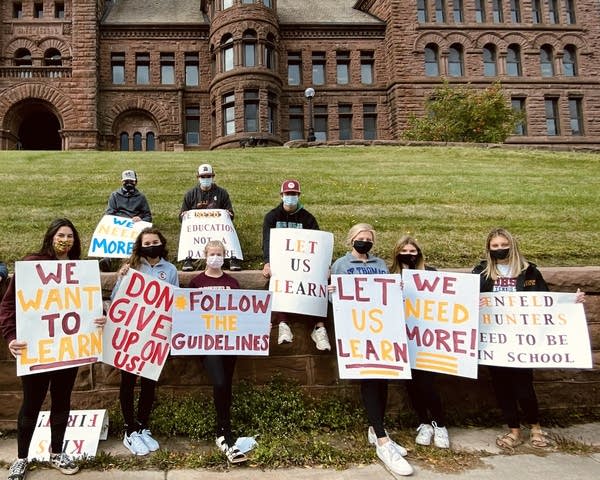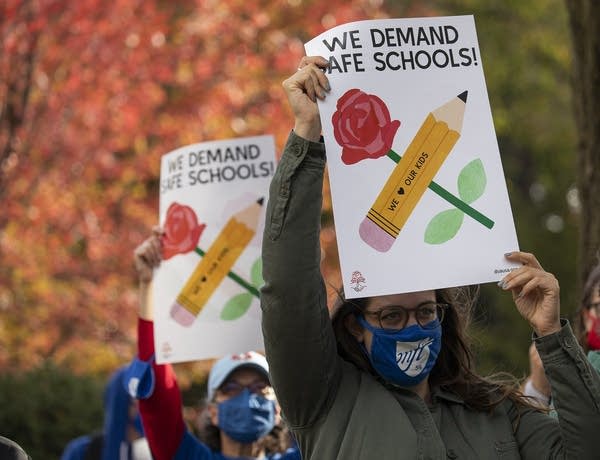Teachers, parents, districts at odds over learning scenarios

Go Deeper.
Create an account or log in to save stories.
Like this?
Thanks for liking this story! We have added it to a list of your favorite stories.
Marina Udd is worried about the students in Duluth Public Schools. She’s a nurse anesthetist and mother to three students who are learning virtually in district high and middle schools.
“Kids aren’t doing well in our area,” Udd said. “And a lot of kids, their safe person is a teacher or a counselor or a para or somebody who works in the school that they’ve developed a relationship over the years, and now those kids don’t have that safe person.”
The district has chosen a hybrid learning option for its elementary students and distance learning for its junior and senior high students.
But Udd wants to change that. She and hundreds of other families have been pressuring the district to give all students the option for hybrid learning if they want it. They’ve also asked for more synchronous learning, better communication with teachers and a clearer outline of how learning will be assessed.
Turn Up Your Support
MPR News helps you turn down the noise and build shared understanding. Turn up your support for this public resource and keep trusted journalism accessible to all.

“Personally for me, my kids are taking some enrichment classes and they’ll probably be fine. But I’m not worried just about my kids. I think every kid should get the same opportunity. Every kid should be allowed to get a good education,” Udd said.
Only about a fifth of Minnesota students are back to full-time in-person schooling. That means the majority of families — not just those in Duluth, Minn. — are unable to rely on schools for educating and taking care of their children in the same way they were able to seven months ago. The lapse in child care support for families means many parents are pushing back and scrambling to figure out their own solutions, putting them at odds with some educators who say they still don't feel safe returning to school buildings.
‘Who can blame parents?’
Deb Henton, the executive director of the Minnesota Association of School Administrators, said that most of her members are getting a pretty consistent message from parents who want their children back to safe, full-time, in-person classes.
“Who can blame parents?” Henton said, “It’s difficult for parents — parents who are working from home to have their students with them learning in a distance learning model. We’re aware of that. And we know it’s difficult for parents to be in a hybrid model where parents have to find child care a couple of times a week, especially difficult in the areas where there’s not day care.”
But for many district leaders, there are multiple factors that make it difficult to start in-person learning. And in some parts of the state, opposition from teachers and other staff is a top concern.
“There are some districts that are experiencing staff who don’t want to come back period. There’s fear on their part, and so superintendents are doing whatever they can to assure staff members,” Henton said. “It’s about safety. I don’t believe it’s about our teachers not wanting to come back and be with kids. They love kids.”
Officials with the Duluth school district and teacher’s union did not respond to requests for comment.
In the Twin Cities, teachers from the Minneapolis and St. Paul school districts took to the streets last week to demand a list of action steps before resuming any form of in-person learning.

Fifth grade Minneapolis Public Schools teacher Lindsey West said she misses her students. But she doesn’t think the district is ready to safely welcome her and her students back in person.
“It’s just still not safe. I’ve worked in schools for a long time, and during the fall and the winter kids get sick,” West said. “Are we really thinking this through? Cases are rising all over the Midwest. To make the assumption that we’re fine here, is presumptuous. And I’m not going to play games with my life, with the lives of my children, and especially the lives of my students.”
Safety and academic quality
West and her colleagues from both Minneapolis and St. Paul teacher unions say they want their districts to publicly negotiate over issues of safety and academic quality in specific schools. They also have asked for lower staffing ratios, resumed hazard pay for education support professionals, expanded access to high-speed internet for students and public acknowledgement of a history of underfunding that has disproportionately negatively affected students of color.
In addition, they want districts to slow the transition to hybrid learning “until it can be done safely and equitably for all students.”
St. Paul Superintendent Joe Gothard said actions and demands from teacher unions were keeping his district from moving forward to resume in-person learning.
“SPFE leadership is in opposition to the return of our students to the classroom,” Gothard wrote in a media release. “Our families are demanding SPPS moves to hybrid learning, our teacher’s union is delaying our ability to do so.”
COVID-19 cases are growing among students and staff at Minnesota schools. According to the latest numbers released late last week, more than 860 students and staff associated with school settings have contracted the virus since early August. But state health officials say transmission of the virus within those schools seems to remain relatively low.
State infectious disease director Kris Ehresmann said that public health officials are studying not merely the rate of infections affecting students and staff, but the clusters of outbreaks. Currently, there are only seven schools in Minnesota that have had a cluster of five or more COVID-19 cases.
“What’s significant is the fact that when we look at the data, the vast majority of facilities or schools have had only one case in their facility,” Ehresmann said. “I think that’s very positive. We’re not seeing large outbreaks at all that have been associated with a school setting.”


